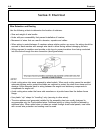
Electrical 2-5
Section 2: Electrical
• Disconnect the negative battery cable of vehicles stored on site to reduce the possibility of
draining the battery by lights or other equipment.
• Do not allow control panels attached to the instrument panel to protrude into the driver and
passenger air bag deployment zones. For additional information, refer to Section 5: Reference
Information in this guide.
• Do not install switches and gauges in the driver or passenger knee impact areas.
• Inspect all Ford gauges, lights and switches for correct operation after instrument panel work is
performed.
• Correctly secure all wiring relocated or removed while working behind the instrument panel to
prevent chafing, squeaks and rattles.
• Provide adequate retention for wiring harnesses so that they are clear of bolts, corners or edges
which could abrade the wires during normal vehicle operation.
• Anticipate misrouted wiring situations and protect all wiring from penetration by screws and raw
edges.
• Weather seal all electrical connectors exposed to the elements.
• Do not use quick splice connectors or wire nuts.
• Install the fuse panel so fuses are readily accessible.
• Make sure that connections are easily accessible for assembly and service.
• Make sure submersible connectors do not lose their seals under extreme assembly conditions
such as bending wires 90 degrees immediately after the connector.
• Whenever using connectors, use a socket (female) connector on the electrical source side and a
plug (male) connector on the electrical load side to reduce the possibility of a short circuit when
disconnected.
• Air bag restraint systems must remain intact as received from Ford Motor Company. Before
modifications are done to the vehicle, the system must be disarmed by following the instructions
provided in the current Expedition Workshop Manual.
• Adherence to the above guidelines is not to be construed as approval by Ford Motor Company
of any specific revisions or additions to the vehicle’s original electrical system.
Keep-Alive Memory (KAM) Power
The electronic engine and transmission control modules require battery power to be supplied at all
times to maintain the keep-alive memory (KAM). Keep this in mind when installing load disconnect
switches or solenoids.
2010 Expedition SSV Modifiers Guide, 07/2009


















